
Basics / Definition
What is vestibular disease in dogs?
Ever seen your dog suddenly start wobbling like they’ve just stepped off a spinning ride at the fair? That might be vestibular disease, a condition that messes with your dog’s internal balance system — basically the parts of their ear and brain that tell them which way is up.
When this system goes haywire, dogs can look dizzy, walk sideways, tilt their heads, or even stumble like they’ve had one too many treats. It’s a little scary to see, but most of the time, it’s not as bad as it looks.
How is vestibular disease different from a stroke?
It’s easy to mix the two up — both can cause sudden balance problems and weird walking patterns. But here’s the deal: with vestibular disease, especially the idiopathic kind (which means we don’t really know why it happens), dogs often start getting better within a few days or weeks.
A stroke, on the other hand, is a whole different ballgame. It has different causes and usually needs more serious monitoring and treatment. The neurology team at MSPCA-Angell explains that distinguishing between the two is super important, especially for older dogs, since stroke patients often have hidden risk factors like high blood pressure or clotting issues that need attention.
What’s the difference between peripheral and central vestibular disease?
Think of it this way:
- Peripheral vestibular disease happens when there’s a problem in the inner ear or the nerve that connects it to the brain.
- Central vestibular disease means the issue is deeper, inside the brainstem or cerebellum.
Dogs with central issues often act more “off” mentally or show extra neurological signs, like weak legs or weird eye movements. Dr. Michelle B. Carnes, a veterinary neurologist (DACVIM), told Today’s Veterinary Practice that central cases tend to have more complicated symptoms — not just the classic head tilt.
Causes & Risk Factors
What are the main causes of vestibular disease in dogs?
Vestibular disease isn’t one single illness — it’s more like a group of balance problems. Anything that throws off the inner ear or brain’s balance signals can set it off. Common culprits?
✅ Ear infections (especially deep ones)
✅ Head injuries or trauma
✅ Brain tumors
✅ Certain toxins or medications
✅ Inflammation or metabolic disorders
According to Veterinary Practice and PDSA, these triggers can affect dogs of all ages, though seniors get hit most often.
What is idiopathic or “old-dog” vestibular syndrome, and why does it occur?
If your older dog suddenly starts wobbling out of nowhere, you might be dealing with idiopathic vestibular disease in dogs, affectionately nicknamed “old-dog syndrome.” No one knows exactly why it happens — theories include minor blood flow issues, age-related changes, or even viral triggers.
The good news? Most dogs start improving within 48 to 72 hours and are back on their paws in a week or two, says Veterinary Partner.
Can ear infections, head trauma, or tumors lead to vestibular disease?
Totally. Chronic or deep ear infections (otitis media/interna) are one of the most common causes. When bacteria or inflammation reach the inner ear, they mess with the structures that control balance.
Meanwhile, tumors — whether in the ear canal or brain — can also disrupt balance signals. Even a hard knock on the head can do it. The team at MSPCA-Angell warns that trauma near the inner ear or brainstem can trigger symptoms that look a lot like idiopathic vestibular disease.
Can certain medications or toxins trigger vestibular symptoms?
Yep — some meds are ototoxic, meaning they can harm the ear. Common offenders include aminoglycoside antibiotics (like gentamicin) and certain antiseptics used in ear cleaning. Even long-term, high doses of metronidazole have been known to cause temporary dizziness or balance problems, according to Veterinary Partner.
Are specific dog breeds or ages more likely to develop vestibular disease?
Senior dogs are more at risk, but breed can play a role too. A massive UK study of 900,000+ dogs found that French Bulldogs, Bulldogs, and Cavalier King Charles Spaniels were more likely to be diagnosed with vestibular disease (AKC). Still, it can happen to any pup, young or old.
Symptoms & Signs
What are the most common symptoms of vestibular disease in dogs?
The signs are usually dramatic — and hard to miss:
🐾 Stumbling or falling to one side
🐾 Circling or walking in strange patterns
🐾 A head tilt (classic!)
🐾 Rapid, jerky eye movements (nystagmus)
Dogs might look completely disoriented or “drunk.” It’s heartbreaking, but try not to panic — it’s often temporary.
Why does a dog with vestibular disease have a head tilt or rapid eye movement (nystagmus)?
The head tilt is your dog’s way of trying to steady themselves. Their brain is getting mixed signals from the inner ear, so they tilt toward the “good” side for balance. Nystagmus (those fast eye twitches) happens because the brain is desperately trying to make sense of the conflicting balance data.
As AKC and Veterinary Practice explain, it’s a telltale clue vets use during exams.
Can vestibular disease cause nausea, vomiting, drooling, or loss of appetite?
Absolutely — imagine being on a spinning carnival ride that never ends. Many dogs with vestibular disease feel queasy, vomit, or refuse food until they regain some stability, says PDSA.
Do symptoms appear suddenly or develop gradually?
Most cases, especially idiopathic ones, appear out of nowhere. One minute your dog’s fine; the next, they’re swaying like they’re on a boat. Gradual onset might mean something more serious — like a tumor — which is why timing helps your vet figure out what’s really going on.
Diagnosis
How do veterinarians diagnose vestibular disease?
Vets usually start by asking about your dog’s history — things like ear infections, trauma, or new meds. They’ll then do a physical and neurological exam, plus routine blood work to rule out other problems.
If things still look fuzzy, your vet might recommend ear exams, X-rays, or even advanced imaging (like an MRI or CT). MSPCA-Angell notes that dogs who don’t show signs of improvement in a few days often benefit from further testing.
What tests help determine if it’s peripheral or central vestibular disease?
- Otoscopy and ear cultures help find infections.
- Radiographs can show bone changes in the ear.
- MRI or CT scans are the gold standard to check for central issues.
- CSF testing (spinal fluid) can reveal inflammation.
Veterinarians at Veterinary Practice say these tests help pinpoint the exact problem, which is key to the right treatment.
Treatment & Medical Management
How is vestibular disease treated in dogs?
Treatment depends on the cause. For idiopathic cases, it’s mostly about supportive care — keeping your dog safe, hydrated, and comfortable while they recover. Vets often prescribe anti-nausea meds and fluids, according to PDSA.
What treatments are used if an inner-ear infection is the cause?
If an ear infection is to blame, antibiotics (sometimes combined with ear flushing or surgery) are the go-to solution. The team at Veterinary Practice stresses the importance of culture testing to choose the right medication.
Can medications help reduce nausea or improve balance?
Definitely. Anti-nausea meds like maropitant or metoclopramide can really help your dog feel less miserable. While there’s no instant “cure,” these meds make recovery more comfortable.
When is surgery necessary for vestibular disease?
Surgery’s rare, but sometimes necessary — like when tumors, ear polyps, or abscesses are discovered. If imaging shows something structural, a veterinary neurologist or surgeon will decide if surgery’s the best option.
Prognosis & Recovery
How long does it take for a dog to recover from vestibular disease?
Good news — many dogs start improving in just a few days! According to Veterinary Partner, most recover within one to two weeks, though older or more severe cases may take longer.
Will a dog regain full balance, or can symptoms linger?
Most pups bounce back completely, though a few keep a small head tilt or occasional wobble. Dr. Carnes notes that even when the tilt sticks around, dogs adapt beautifully and live normal, happy lives.
Is vestibular disease life-threatening, or can dogs live normally afterward?
Thankfully, it’s usually not life-threatening. The real danger lies in dehydration, poor eating, or missing a deeper issue like a tumor. With good care, most dogs live long, full lives after recovery.
Home Care & Supportive Care
How can I care for my dog safely during vestibular recovery?
Keep things calm and cozy. Use non-slip mats, block off stairs, and create a small safe area where your dog can rest without falling. Sit with them, offer reassurance, and let them know they’re doing great — emotional comfort matters too!
What adjustments should I make at home—like feeding, walking, or using stairs?
- Keep bowls low and steady.
- Use a towel or sling for support during walks.
- Avoid slippery floors.
Small changes like these make recovery smoother (and prevent extra vet visits).
When should I contact the vet again during recovery?
If your dog isn’t improving after a few days — or if they’re vomiting, having seizures, or acting confused — it’s time to call your vet or the MSPCA-Angell neurology team.
Prevention & Monitoring
Can vestibular disease be prevented?
You can’t always prevent it, but you can lower the odds by:
✅ Keeping ears clean and dry (without harsh products)
✅ Avoiding ototoxic meds
✅ Treating ear infections early
✅ Managing overall health (thyroid, blood pressure, etc.)
What warning signs mean I should take my dog to the vet immediately?
Head tilt, falling, vomiting, or confusion are red flags. The quicker your dog gets checked, the better the outcome.
Special Situations
Can puppies or young dogs get vestibular disease, and are their causes different?
Yes, though it’s rare. In younger dogs, it’s often due to infections, congenital issues, or head trauma rather than the idiopathic “old-dog” type.
How does central vestibular disease affect diagnosis and prognosis?
Central disease usually means something more serious — like a tumor or brain inflammation. It takes longer to diagnose and often has a slower recovery, as AKC and MSPCA-Angell explain.
Can there be long-term complications like a permanent head tilt or imbalance?
Yep, sometimes. A little tilt might stick around, but it rarely affects a dog’s happiness. Most dogs adjust just fine.
How much does it usually cost to diagnose and treat vestibular disease?
Costs vary. A simple vet visit and meds might be a few hundred dollars. Add imaging, hospitalization, or surgery, and it can run into the thousands. PDSA suggests always discussing budget and treatment options upfront.
Wrapping Up
Seeing your dog stumble around can be terrifying, but vestibular disease in dogs often looks worse than it is. With love, patience, and veterinary care, most pups bounce back beautifully. Experts like Dr. Michelle B. Carnes and the MSPCA neurology team are constantly learning more about this puzzling but highly treatable condition.
If your dog starts tilting, wobbling, or acting dizzy — don’t panic. Get them checked, offer support, and remember: they might just need a little extra TLC while their world stops spinning
please leave comments
sources
- https://www.akc.org/expert-advice/health/vestibular-disease-in-dogs/
- https://vcahospitals.com/know-your-pet/vestibular-disease-in-dogs
- https://www.petmd.com/dog/conditions/neurological/vestibular-disease-dogs
- https://sem3.toolspd.com/analytics/organic/overview?q=https%3A%2F%2Fvcahospitals.com%2Fknow-your-pet%2Fvestibular-disease-in-dogs&db=us&searchType=url
- https://www.vetspecialists.co.uk/fact-sheets-post/vestibular-syndrome-in-dogs-and-cats-fact-sheet/
- https://veterinarypartner.vin.com/default.aspx?pid=19239&id=4951444
you may like it






